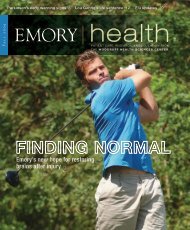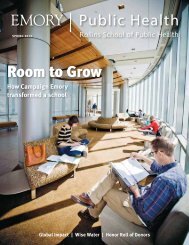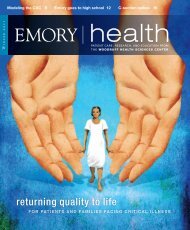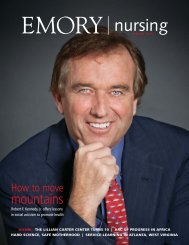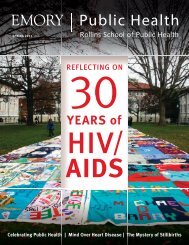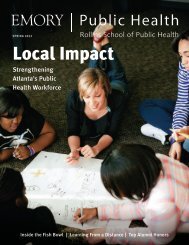Living - Woodruff Health Sciences Center - Emory University
Living - Woodruff Health Sciences Center - Emory University
Living - Woodruff Health Sciences Center - Emory University
You also want an ePaper? Increase the reach of your titles
YUMPU automatically turns print PDFs into web optimized ePapers that Google loves.
FeAture MAtRIx CAnCER CARE<br />
Just a few years ago, Moss would have<br />
had to go out of state to find this kind of<br />
treatment. However, in those years, both<br />
<strong>Emory</strong> and Georgia have been pouring massive<br />
resources into Winship to build a worldclass,<br />
matrix cancer center (see box on page<br />
5). the institute offers patients a breadth<br />
On a Friday 13 two years ago, one<br />
week after his first wedding anniversary,<br />
Ned Crystal got lucky. He was<br />
diagnosed with cancer—a diagnosis that<br />
saved his life. Crystal originally had surgery<br />
for a hematoma above his right knee<br />
that wouldn’t go away more than a year<br />
after an ice hockey injury. It turns out the<br />
eggplant-sized mass was stage 3 aggressive<br />
sarcoma. Crystal underwent treatment<br />
(six cycles of chemo and 37 doses of<br />
radiation) at <strong>Emory</strong> with his wife, Kristina,<br />
by his side. Today, a cancer-free Crystal is<br />
using his luck to reach others through a<br />
sarcoma support group at <strong>Emory</strong> that he<br />
helped start and two initiatives—a silent<br />
auction and a pheasant hunt— that will<br />
raise support for sarcoma research.<br />
and depth of cancer care from basic science<br />
research and clinical trials to prevention in<br />
the larger population.<br />
“Matrix cancer centers are engines for<br />
scientific discovery,” says Winship’s director<br />
Brian Leyland-Jones. “Most significant<br />
advances in cancer research and care are<br />
developed at academic cancer centers.”<br />
<strong>Emory</strong> hopes to parlay strengths—<br />
including leadership in basic science,<br />
surgical oncology, nanotechnology,<br />
health disparities research, and imaging<br />
technologies—into designation by<br />
the national Cancer Institute (nCI) as a<br />
comprehensive cancer center. the designation<br />
would bring more nCI funding<br />
and clinical trials to Winship—and to<br />
Georgia. And that translates into more<br />
help and hope for Georgians with cancer.<br />
It was this goal that prompted the<br />
state, through the Georgia Cancer<br />
Coalition (GCC), to invest $50 million<br />
from tobacco settlement funds in<br />
Winship. “We are the largest state in the<br />
nation without a comprehensive cancer<br />
center,” says William<br />
todd, GCC president<br />
and CEO. “It goes way<br />
beyond window dressing<br />
or civic boasting. In our<br />
quest to shorten the time<br />
from discovery to application,<br />
we need robust<br />
clinical trial networks<br />
where investigatorinitiated<br />
trials at an nCI<br />
center are available to<br />
community hospitals,<br />
bringing the benefits<br />
of science to patients<br />
more quickly. A comprehensive<br />
cancer center<br />
designation for Winship<br />
would bring more of<br />
those nCI clinical trials<br />
to Georgia.”<br />
From the bench<br />
In the beginning, there<br />
is a gene that mutates.<br />
that’s the genesis of every cancer. trying<br />
to identify those genes, determining what<br />
causes them to mutate, and developing<br />
agents that can either prevent or repair the<br />
damage or stop the defective cells from multiplying<br />
is a major focus of Winship’s basic<br />
scientists.<br />
In one approach, researchers are studying<br />
the ability of tumor cells to repair damage<br />
to their DnA caused by an anti-tumor<br />
treatment. “that’s why you can kill 99% of a<br />
tumor cell population and not wipe out the<br />
cancer,” says Paul Doetsch, Winship’s deputy<br />
director for basic research. “that remaining<br />
1% evolves into a drug-resistant form and<br />
then grows. So if we are able to target the<br />
tumor’s DnA repair pathway with a drug,<br />
in many cases we could eliminate the tumor<br />
cells’ ability to become resistant, thus making<br />
them sensitive to treatment.”<br />
that’s what Winship investigators are trying<br />
to do with triple-negative breast cancer.<br />
the most aggressive form of breast cancer,<br />
it strikes African-American women at twice<br />
the rate of whites. triple-negative breast cancer<br />
is so named because it lacks three receptors<br />
known to fuel most breast cancers, and<br />
that means this type of cancer is resistant<br />
to the most successful treatments for breast<br />
cancer, which target<br />
these receptors.<br />
A Winship<br />
team of basic science<br />
researchers has<br />
proven successful in<br />
overcoming that resistance<br />
by reactivating<br />
estrogen and progesterone<br />
receptors in<br />
triple-negative breast<br />
cancer cells in the<br />
lab. that reactivation<br />
rendered them sensitive<br />
to tamoxifen, the<br />
most widely used drug to treat breast cancer.<br />
the basic scientists then handed off the<br />
lab results to a clinical team, which is using<br />
them to design a clinical trial to be conducted<br />
with seven community hospital partners<br />
throughout the state. “this work could<br />
not have been done at any place other than<br />
a matrix cancer center,” says Doetsch. “At<br />
<strong>Emory</strong>, our basic science information gets<br />
translated into animal studies or cell culture<br />
studies, which are then used to inform clinical<br />
trials that may have a very real positive<br />
impact on patients.”<br />
“At <strong>Emory</strong>, our basic science<br />
information gets translated<br />
into animal studies or<br />
cell culture studies, which are<br />
then used to inform clinical<br />
trials that may have a very<br />
real positive impact on<br />
patients.” –Paul Doetsch, Winship<br />
deputy director for basic research<br />
To patients<br />
translating research into practice is the ultimate<br />
goal of the cancer center. Discoveries<br />
in the lab are used to develop new drugs and<br />
therapies, which may then be tested in clinical<br />
trials. the trip from the research bench to<br />
the bedside is often a relatively short one at<br />
Winship, just as it was for Kristen Moss.<br />
One reason for that is <strong>Emory</strong>’s support<br />
of interdisciplinary collaboration, says Fadlo<br />
Khuri, chair of of hematology and medical<br />
oncology at <strong>Emory</strong> and deputy director for<br />
translational research at Winship. “Because<br />
of the complexity of the many diseases<br />
known as ‘cancer,’ finding new avenues for<br />
prevention, treatments, cures, and causes<br />
involves work in a host of scientific disciplines<br />
from chemistry and epidemiology<br />
to pathology and oncology. these disciplines<br />
and others all come together within<br />
Winship.”<br />
In fact, <strong>Emory</strong> has one of the strongest<br />
collaborative environments<br />
of any<br />
institution in the<br />
country, says Dong<br />
Moon Shin, director<br />
of Winship’s chemoprevention<br />
program.<br />
“At other institutions,<br />
researchers compete<br />
for tumor tissue, for<br />
access to imaging,<br />
for resources, but<br />
here everyone is on<br />
the same team. As a<br />
result, discoveries in<br />
the lab tend to get translated into treatments<br />
more quickly.”<br />
A group of <strong>Emory</strong> researchers, for<br />
example, has developed a biodegradable<br />
nanodrug that promises to attack cancer cells<br />
while leaving healthy cells untouched. the<br />
team created a nanoparticle by linking the<br />
cancer drug taxol and folic acid with a biodegradable<br />
heparin molecule. the folic acid<br />
acts like a heat-seeking missile, flying past<br />
normal cells to crash into the many folate<br />
receptors in head and neck tumors to deliver<br />
its payload of taxol. Since normal cells are<br />
What is a matrix cancer center?<br />
It starts with interdisciplinary teams of researchers,<br />
physicians, epidemiologists, nurses, engineers, and<br />
social workers, who come together to understand cancer<br />
along its entire continuum and to treat it. The key<br />
focus is building up the full <strong>Emory</strong> family into a huge<br />
translational force—a matrix—for cancer research,<br />
treatment, and prevention.<br />
In the lab, researchers identify specific gene<br />
mutations involved in the development of cancer and<br />
develop biomarkers for early detection of tumors.<br />
In the clinic, physicians use those discoveries to test<br />
new drugs and therapies in clinical trials. At the<br />
population level, epidemiologists study risk factors<br />
and prevention strategies to help shape public policy<br />
on cancer. And <strong>Emory</strong> Winship goes a step further, to<br />
provide public information about programs, cancer<br />
education, and outreach to health care professionals<br />
and the community.<br />
All that is supported by core facilities, such as<br />
those for cell imaging, biomarker profiling, and pathology.<br />
So while a typical researcher who needs to look<br />
inside cancer cells to study DNA might be stymied<br />
by locating and paying for the use of a microscope<br />
powerful enough to complete the work, <strong>Emory</strong><br />
Winship researchers need only go to the cell-imaging<br />
core with high powered microscopes and staff expertise<br />
to use them.<br />
Beyond the team on its own campus, Winship<br />
draws on unparalleled community partnerships—the<br />
CDC, American Cancer Society, Georgia Institute of<br />
Technology, Georgia Cancer Coalition, and Georgia<br />
Research Alliance, to name a few.<br />
4 eMory heAlth<br />
Winter 2008-2009 5



